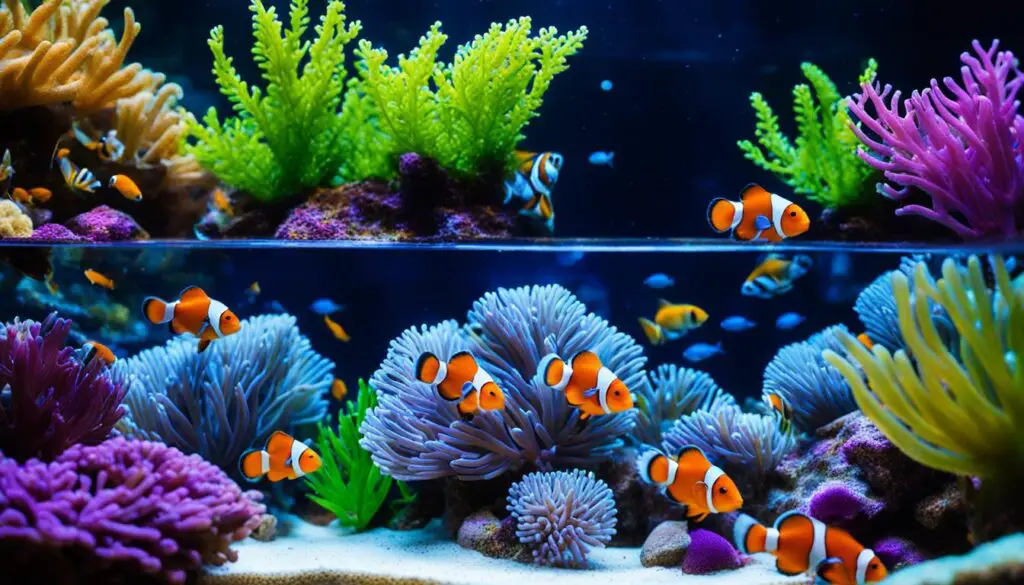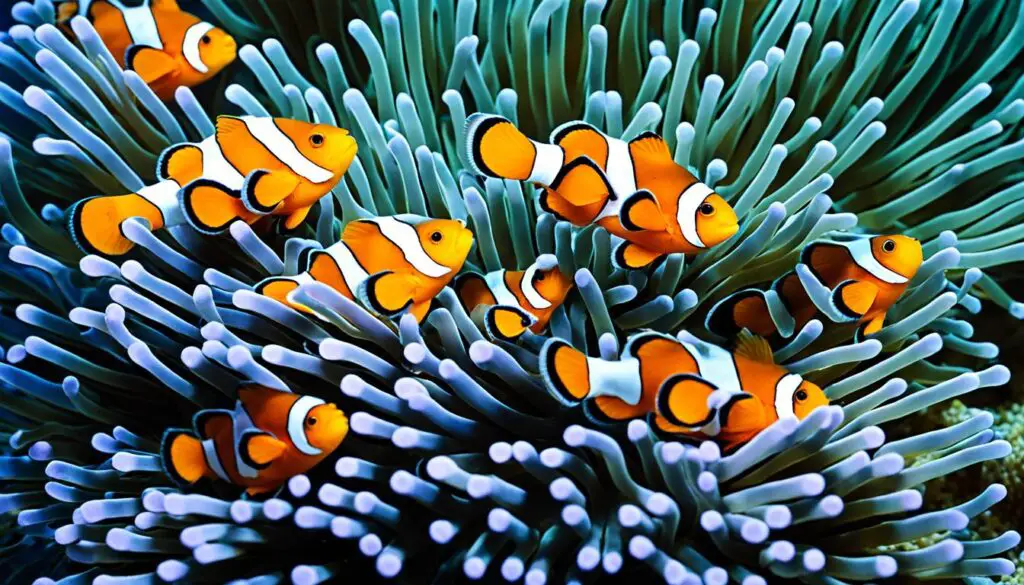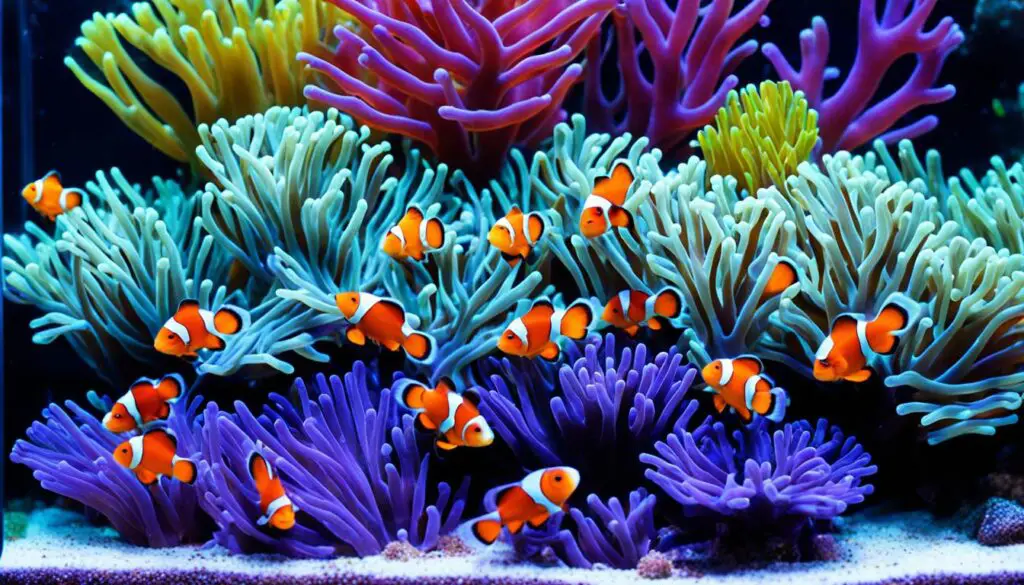DIY Clownfish Tank Setup: Insider Secrets for Success
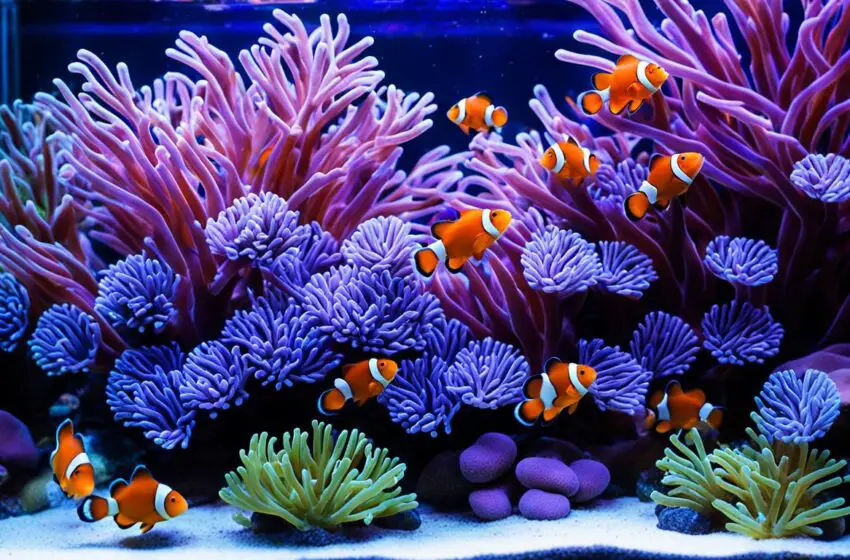
Clownfish are truly fascinating creatures. They bring bright colors and unique personalities to your saltwater tank. Their partnership with anemones or soft corals is like magic. This bond turns your tank into a peaceful, beautiful world.
For anyone setting up a clownfish tank, learning some insider tips is key. These insights will help your aquarium flourish. So, let’s dive into the secrets of making your clownfish tank not just good, but great.
Key Takeaways:
- A successful clownfish tank setup requires careful consideration and planning.
- Choosing the right tank size and equipment is crucial for the well-being of your clownfish.
- Providing a suitable habitat with hiding places and proper lighting mimics their natural environment.
- Regular water testing, filtration, and maintenance are vital for the health of your clownfish.
- Introducing compatible tank mates is important to maintain a peaceful and harmonious aquarium.
The Complexities of Clownfish Complexes – 6 Main Groups
Clownfish are part of a big family with over 30 species. You can group them into the Skunk, Percula, Maroon, Clarkii, Saddleback, and Tomato complexes. Each complex has its own looks and features, giving fish keepers many choices.
In the Skunk Complex, you’ll find the Skunk Clownfish and the Pink Skunk Clownfish. They are known for their stripes and bright colors, making tanks lively.
The Percula Complex has the True Percula Clownfish and the Ocellaris Clownfish. Their orange bodies and white stripes make them stand out and beloved by many.
The Maroon Complex includes the Maroon Clownfish, known for its deep red color. It’s a beautiful fish for marine tanks.
The Clarkii Complex is led by the Clarkii Clownfish, with its colorful stripes. This complex brings bright colors under the sea.
In the Saddleback Complex, you can meet the Saddleback Clownfish and the Sebae Clownfish. They have unique shapes and markings.
Finally, in the Tomato Complex, there is the Tomato Clownfish with its bold red color. It brightens up any tank.
These classifications help fish keepers pick the perfect clownfish for their tanks. Each complex offers a different look, making aquariums a joy to behold.
No Laughing Matter – Clownfish and Sea Anemones
Clownfish and sea anemones form a unique pair in aquariums. Most sea creatures avoid anemones because they sting. But, clownfish are safe and get benefits from them. This arrangement is a win for both sides.
Clownfish protect anemones by keeping them free of pests. They also help by giving the anemone nutrients in their waste. This way, both animals help each other stay healthy.
“Clownfish and sea anemones have evolved together over time, developing a remarkable understanding and reliance on one another. It’s a fascinating example of nature’s intricate harmony.” – Marine Biologist
The anemone gives the clownfish a hiding spot and keeps them safe. The anemone’s tentacles scare off enemies. But, the clownfish is not hurt by the anemone. This duo truly works as a team to survive.
In aquariums, clownfish might also pair up with corals or rocks. This gives them even more places to hide and live. It makes the tank look better, too.
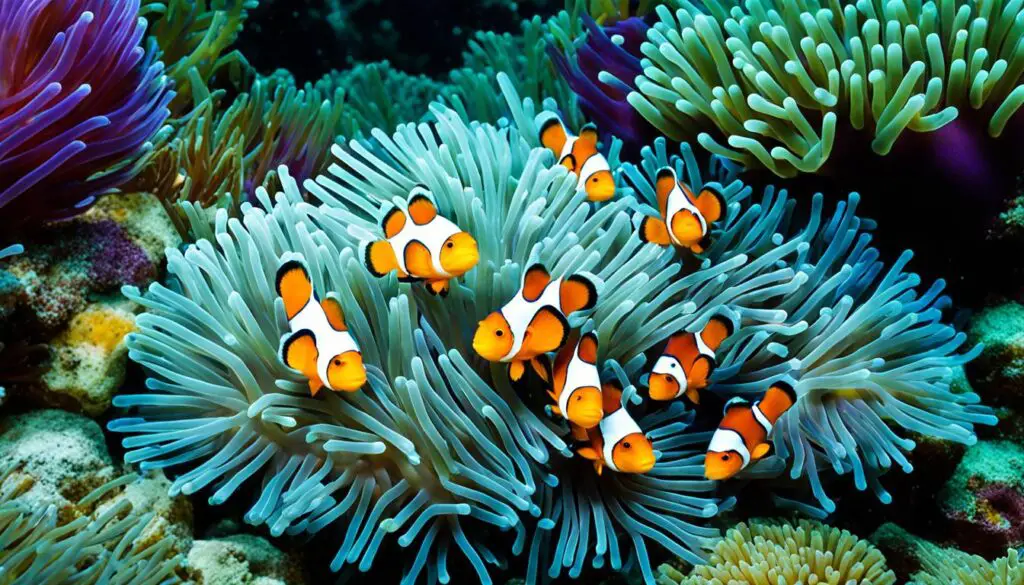
The Benefits of Clownfish and Sea Anemone Symbiosis:
- Protection: Clownfish keep the anemone safe from harm and clean.
- Nutrient Exchange: They help feed the anemone by their waste.
- Safe Haven: Anemones protect clownfish from danger with their tentacles.
- Mutualistic Relationship: Both clownfish and anemones help each other live well.
The link between clownfish and sea anemones is amazing. It shows how beautiful and balanced ocean life is. Aquariums can be made to show this wonder. This knowledge lets fishkeepers create healthy, stunning homes for their fish.
| Clownfish | Sea Anemone |
|---|---|
| Immune to anemone’s stinging tentacles | Provides shelter and protection to clownfish |
| Protects the anemone from parasites | Deters potential predators with stinging tentacles |
| Contributes nutrients through waste | Absorbs nutrients from clownfish waste |
| Forms attachments to other structures in the tank | Creates a safe haven for clownfish |
The Captive Clownfish – Facts Every Aquarist Should Know
Keeping captive clownfish is not just about looks. It’s also about understanding their biology. This knowledge is key to a lively and peaceful tank.
Clownfish Immunity and Adaptations
Captive clownfish have a cool trick up their sleeves. Over time, they learn how to resist anemone toxins. They do this by growing a protective mucus layer when brushing against anemones. This helps them live safely with their anemone buddies and defend against threats.
Sequential Hermaphroditism in Clownfish
Clownfish have a unique way of organizing their community. They can change from male to female. This skill keeps their social life in the aquarium in check. Knowing this helps aquarists keep their clownfish group healthy and happy.
Native Environment vs. Captive-Bred Aggression
Clownfish might fight, but where they came from plays a big role. Those caught from the wild are often more aggressive. They are used to competing for space. The ones bred in captivity, however, are usually calmer. They didn’t have to fight for room growing up.
“Understanding the biology and behavior of captive clownfish is crucial for creating a thriving aquarium. By providing a suitable environment and considering their unique adaptations, we can ensure these captivating fish flourish in captivity.”
Knowing these facts helps aquarists build a great home for clownfish. It’s about understanding their needs. This leads to a happy tank for both the fish and their keepers.
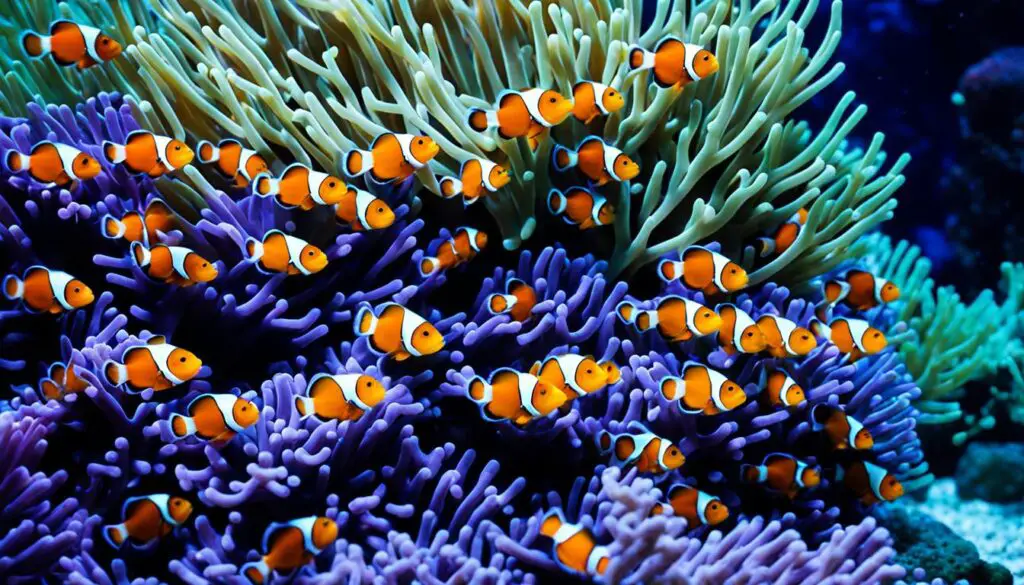
Conclusion
Understanding how clownfish interact with sea anemones helps us know how to care for them. By choosing the right species and setting up the tank correctly, you can have a happy, healthy clownfish tank. This makes your aquarium a colorful and lively place.
With the right advice, you can make a great home for your clownfish. Watching them in your tank will be fascinating. It’s all about creating a space where they can thrive.
Creating the best environment for clownfish involves careful work. By focusing on proper care and attention, you can enjoy their beauty. Join the fun of keeping clownfish and have a stunning fish tank to enjoy.
FAQ
What are the main groups of clownfish?
There are six main groups of clownfish: the Skunk Complex, Percula Complex, Maroon Complex, Clarkii Complex, Saddleback Complex, and Tomato Complex.
How do clownfish interact with sea anemones in the aquarium?
Clownfish and sea anemones have a special bond. They help each other survive. Clownfish keep the anemone clean and safe for eating, and the anemone gives the clownfish protection from danger.
What are the important facts about keeping captive clownfish?
Keeping clownfish in tanks is fascinating. They get used to not being hurt by anemones. They can also change from male to female to keep the group balanced. How mean they are can change based on whether they were caught in the wild or bred in a tank.
How can I create a successful clownfish tank setup?
For a great clownfish tank, pick the right kind of clownfish. Set up the tank just right for them. Make sure their friends in the tank get along with them.

